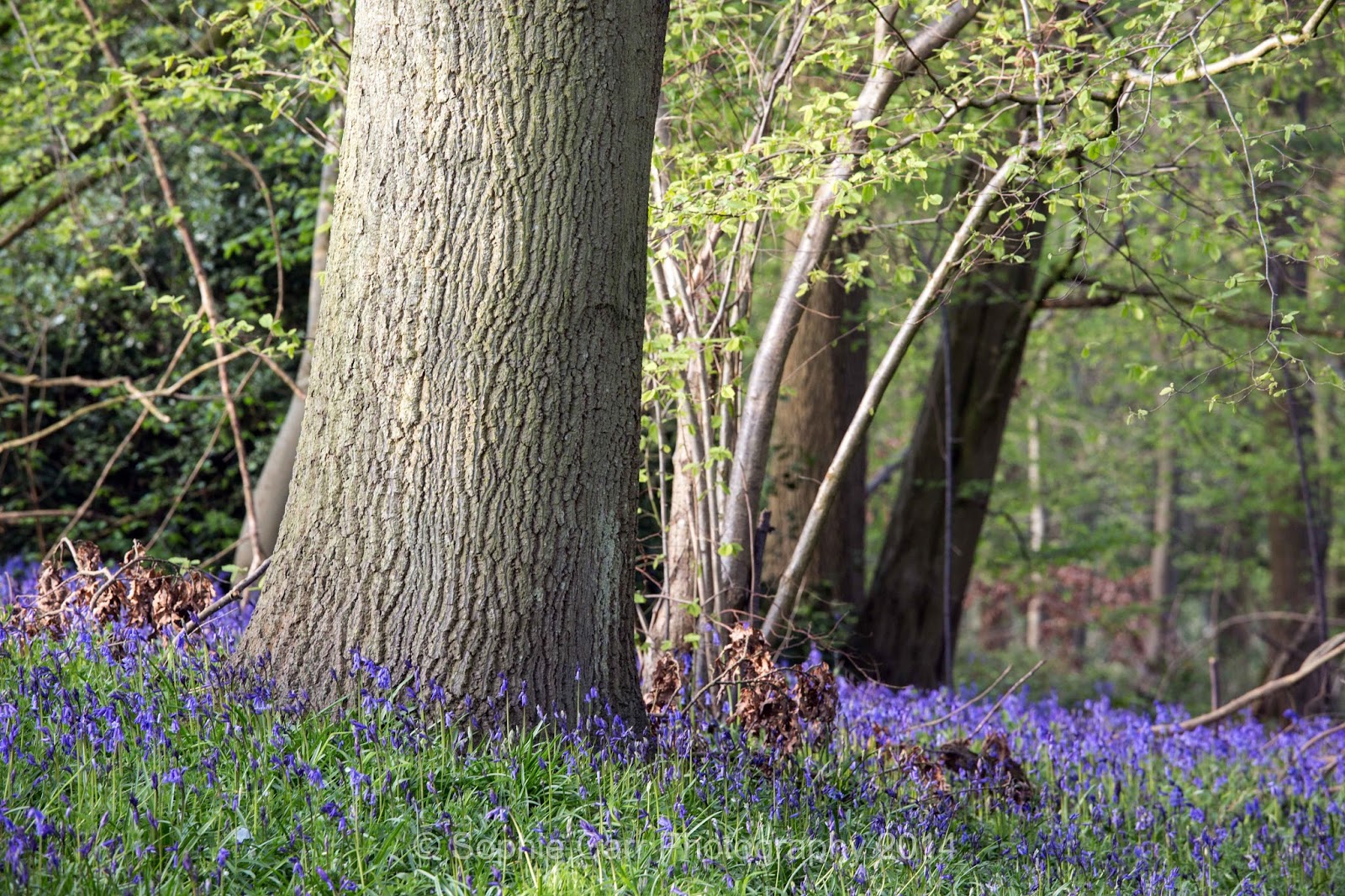 ISO 2500, f/2.8, 25 secs
ISO 2500, f/2.8, 25 secs
I learned a fair bit from various other blogs that I dipped in and out of, so thought I'd reciprocate and give a few basic tips - from useful equipment to useful techniques.
EQUIPMENT TIPS
1) Tripod
Every shot you will take will be a long exposure, so a sturdy tripod is an absolute necessity. I guess you could rest a camera on something, so a beanbag might do. But take a tripod. Make sure you tripod is sturdy enough to hold the weight of your camera and lens (I have a lightweight one which is handy for hiking but useless for holding my 5D with a heavy lens, like the Zeiss I rented or the Canon 24-70mm I have).
2) Warm clothes
Northern lights are visible in the higher latitudes of the northern hemisphere when it's dark - usually from the autumn to the spring equinoxes. It is possible to see them all year round if it's actually dark, but the further north you go, the less darkness you get in the summer. In order to see the lights, it also has to be clear (or a bit cloudy, in which case you may get a glimpse through the cloud). As a result of all this, it's likely to be cold - often extremely cold, so waiting for the lights to appear may be a rather chilly business. A warm car is helpful while you're waiting, but once you actually start to see the lights it'll become addictive and you'll be out for some time. Take a lot of warm clothes - lots of thermal under-garments, thick socks and warm gloves, hats, scarves, down, etc.. Don't underestimate how cold it can be. You don't want to have to curtail your photography (or just enjoyment of the spectacle) because you didn't wrap up warm enough. No amount of warm clothes will keep you warm for hours, so eventually your feet will freeze and you'll give up for the night.
3) A camera with good low-light capability
In order to capture the lights you need a camera with great low-light capability, so not too much noise at high ISO levels. I have a Canon 5D Mark iii which certainly has this feature. If you're going up to the arctic in winter and don't have a decent camera, it might be worth renting one, which if you shop around might not be as expensive as you think. Otherwise, a mid-range DSLR will probably be adequate, but you'll have more noise to deal with in the shot (which might make it look grainy).
 ISO 2000, f/8, 8 secs
ISO 2000, f/8, 8 secs
As well as a camera with good low-light capability, you will also want as wide a lens as possible, with as low an f-stop as possible, in order to let as much light in as possible in as short a period of time. The wide-angle will be useful to capture a sky full of lights and stars, as well as a bit of foreground to add some interest. Again, if you don't have such a lens, consider renting one (I rented a Zeiss Distagon 21mm f/2.8 lens from lensesforhire.co.uk and was extremely glad that I did!). Obviously such a lens will be good for all round landscape photography too, which if you're in a country that gets northern lights, the chances are the scenery will be pretty nice in the daytime too. During my research for lenses, I learned about a thing called coma which is where stars are a bit blurry - the better the lens, the less coma you're likely to get. I didn't get this with the Zeiss. If you're not blowing up the photo it probably won't matter too much, but just something else to bear in mind.
5) Torch
You'll be fumbling around in the dark to get set up, so a head-torch (or flashlight) is a great little accessory to have with you (don't rely on your iPhone torch as the battery will probably run out and you might not have a spare hand!). The torch can also be used for shining on something to try to focus (if it's close) and also to do a bit of light-painting - lighting things up briefly in the foreground (be sparing with this!). If you're near a road a car may drive past and do this for you...
 ISO 1600, f/2.8, 20 secs (with car driving past)
ISO 1600, f/2.8, 20 secs (with car driving past)6) Spare batteries
Batteries wear out more quickly in the cold, but also if you're doing long exposures, so make sure you're fully-charged before you set out and have a spare or two. Consider the non-branded ones for cheapness, but remember that they also don't hold their charge as long (in my experience anyway). I also got a car-charger this year, so was able to recharge batteries as I was driving along.
TECHNIQUE TIPS
A lot of this will come down to practice, the available light and your equipment, but here are a few tips on technique.
1) Get to know your camera, lens and its focus
It's impossible to focus properly in the dark, so it's a good idea to play around with the infinity end of the lens to get an idea of where you'll need to focus (and set it to manual, otherwise the poor thing will whizz in and out trying to focus but failing to!). If you focus on infinity itself, it's likely that any foreground will be out-of-focus; the focus spot for distant landscape will probably be just a fraction before that. If you've got something closer in the foreground, obviously you'll need to move off the infinity marker even more and a good torch might help to focus it (it's tricky!). Once you start shooting you should review a few images, zoom right in to make sure they're in focus, and try again if not until the landscape looks sharp. Also play around with the ISO settings inside in a dark-ish room so that you can see what kind of noise each high ISO produces. Also google it, to see what other people say about the camera!
I've seen it recommended to scope out a location during daylight hours, and mark the focus on your lens. The problem with this is that the lights may then turn out to shine in a different place, leaving your plan in shreds. And you may forget the marked spot on the lens, since you'll probably take more shots in the meantime.
 ISO 3200, f/2.8, 15 secs
ISO 3200, f/2.8, 15 secs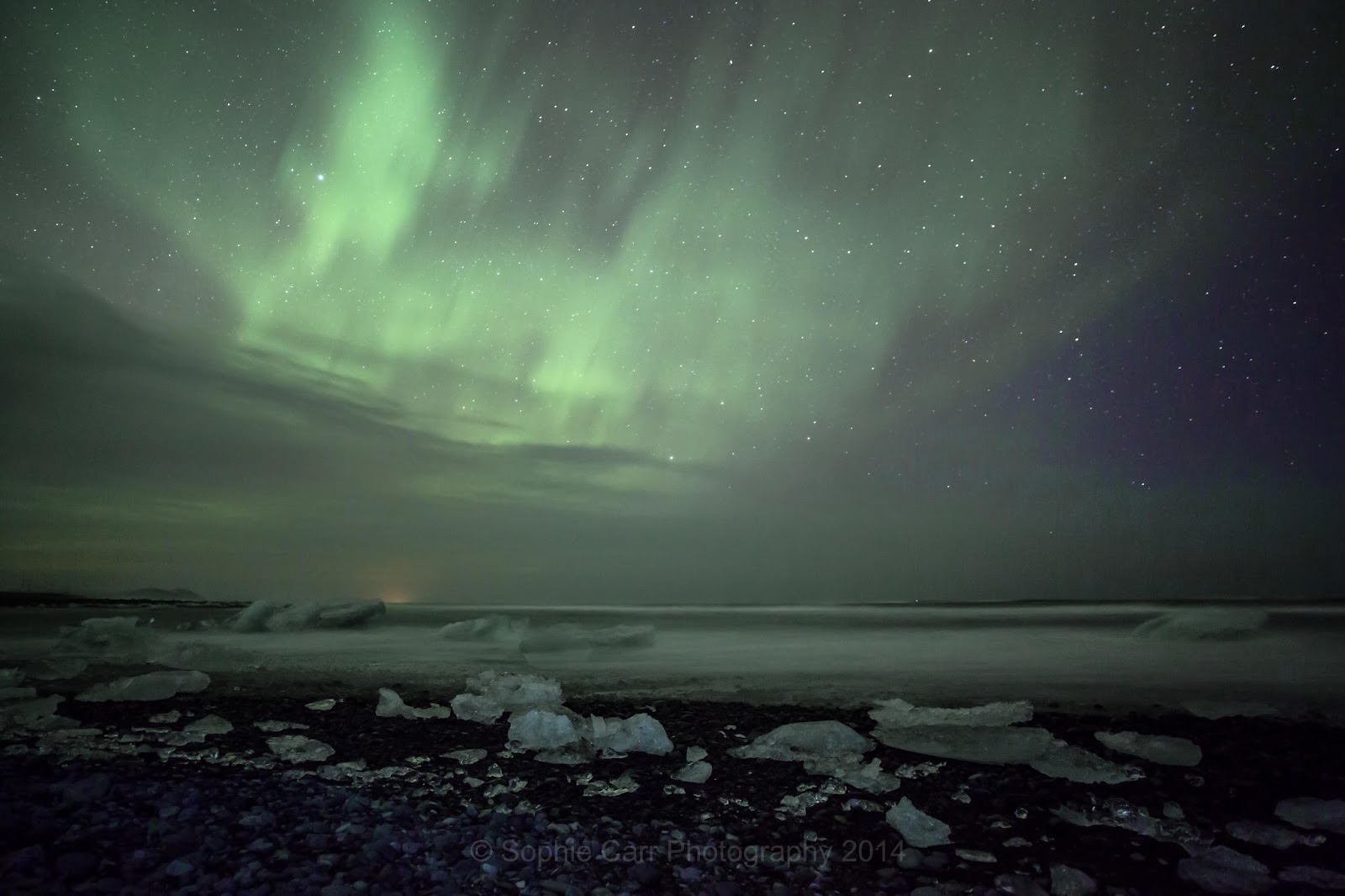 ISO 2000, f/2.8, 15 secs
ISO 2000, f/2.8, 15 secs
2) Shoot in M (fully manual) and try out a few combinations
I'd start with an ISO of around 2500, an f-stop of 2.8 (go as low as you can) and a shutter speed of around 10-12 seconds. From this, then review your image and see if you need to increase the time (you probably will, especially if you're in the middle of nowhere, it's hours after sunset and there's no moon, bright stars or ambient light). Don't expose for longer than 30 seconds, especially if your lens isn't that wide, otherwise the stars will start to show movement which just looks a bit blurred. Even for shorter exposures you'll probably see a little star trail movement at the edges of the shot. You want the stars in the majority of the shot to be sharp. The wider the lens, the longer you'll be able to shoot without the trails showing.
 ISO 2000, f/2.8, 8 secs
ISO 2000, f/2.8, 8 secs
If the aurora are bright then you can either reduce the ISO (less noise) or reduce the shutter speed. I haven't tried changing the aperture, but you could go to f/4.0 and see what happens. I tend to over-expose each shot by a couple of stops, which seemed to work pretty well. Some of the lights I saw this year were so bright, though, that I ruined a few shots by over-exposing the green light (something I was surprised I could do!). If there are any lights in the shot, they will come out extremely bright, so you'll need to compensate for that by reducing the exposure time (or hoping you can reduce them in post-processing).
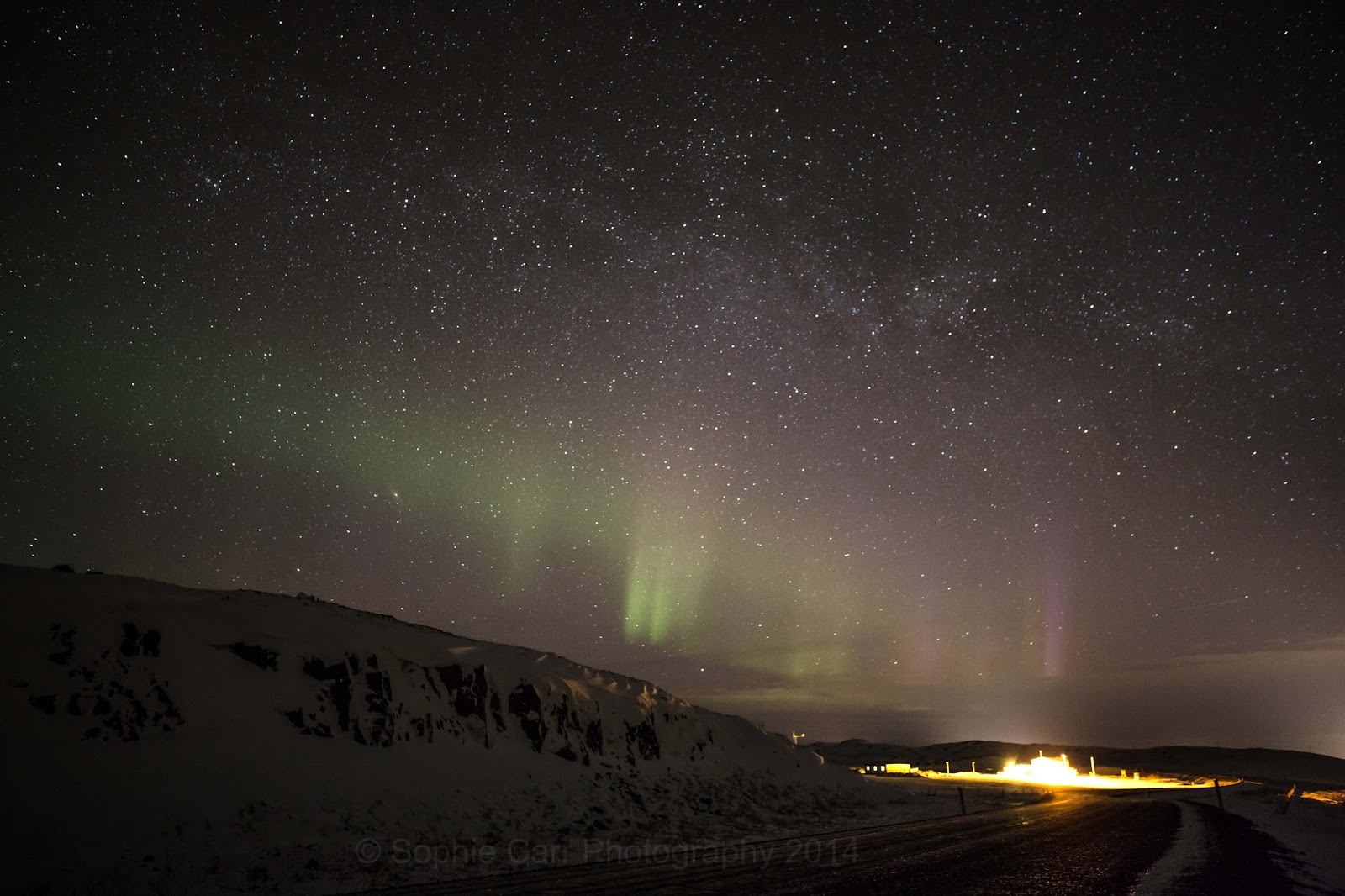 ISO 2000, f/2.8, 20 secs
ISO 2000, f/2.8, 20 secs3) Make sure there's something of interest in the foreground
It is quite tricky to compose in the dark, and also to focus, as mentioned above. Try to find a location which has something of interest in it, though, above which the lights can do their thing. Trees, mountains, icebergs, water, huts, you, etc.. add to a shot, although they obviously introduce the difficulty of exposing and focusing correctly. Some people take multiple exposures including one with a lighter foreground to blend with a darker shot of the sky; others just correct in post-processing (I do the latter - seems to work okay if you've over-exposed a little). Don't forget to try portrait shots as well as landscape.
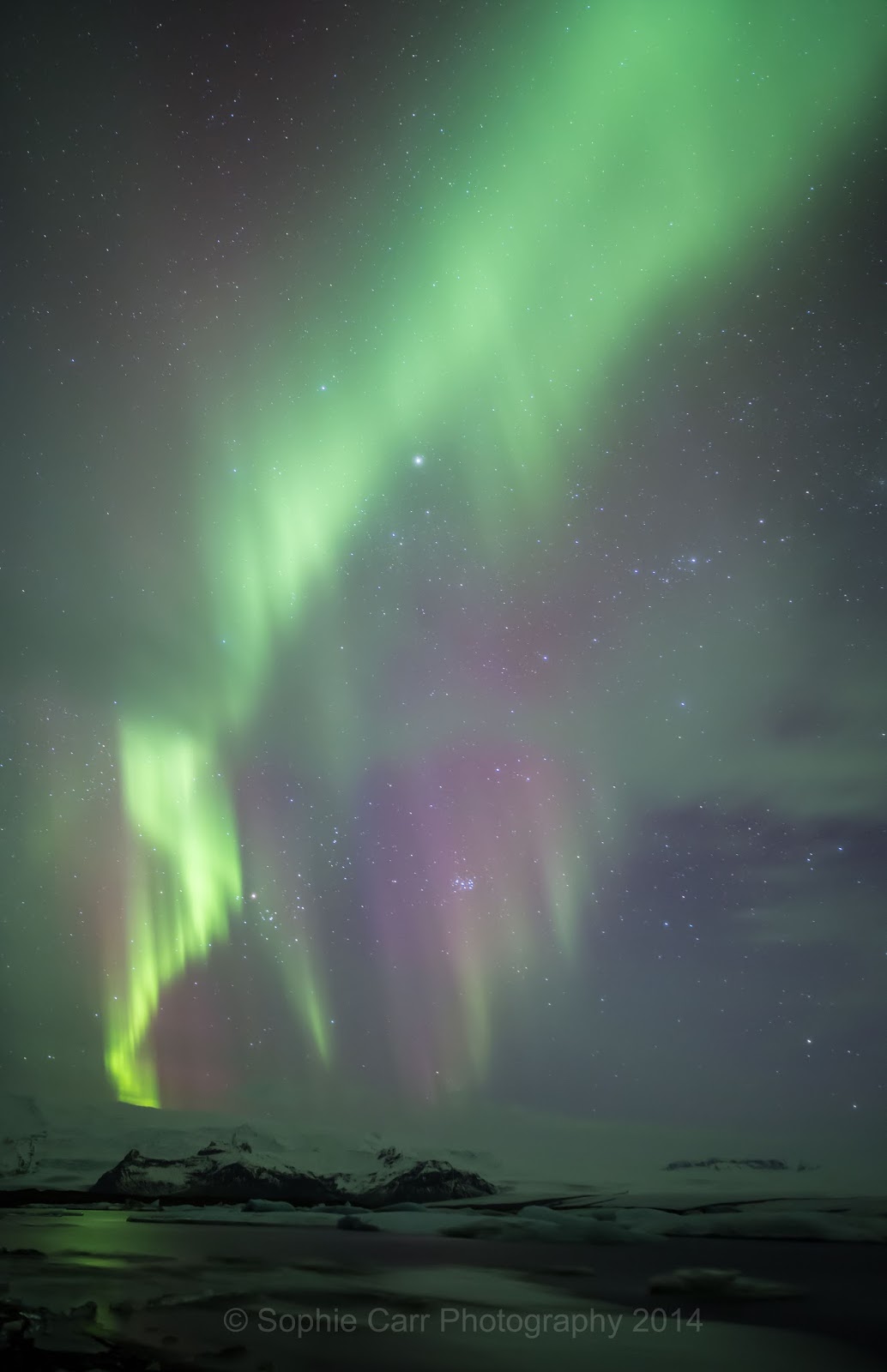
ISO 2500, f/2.8, 25 secs
Having said all that, sometimes it's good to just lie back on the ground and look up at the lightshow and capture just that...
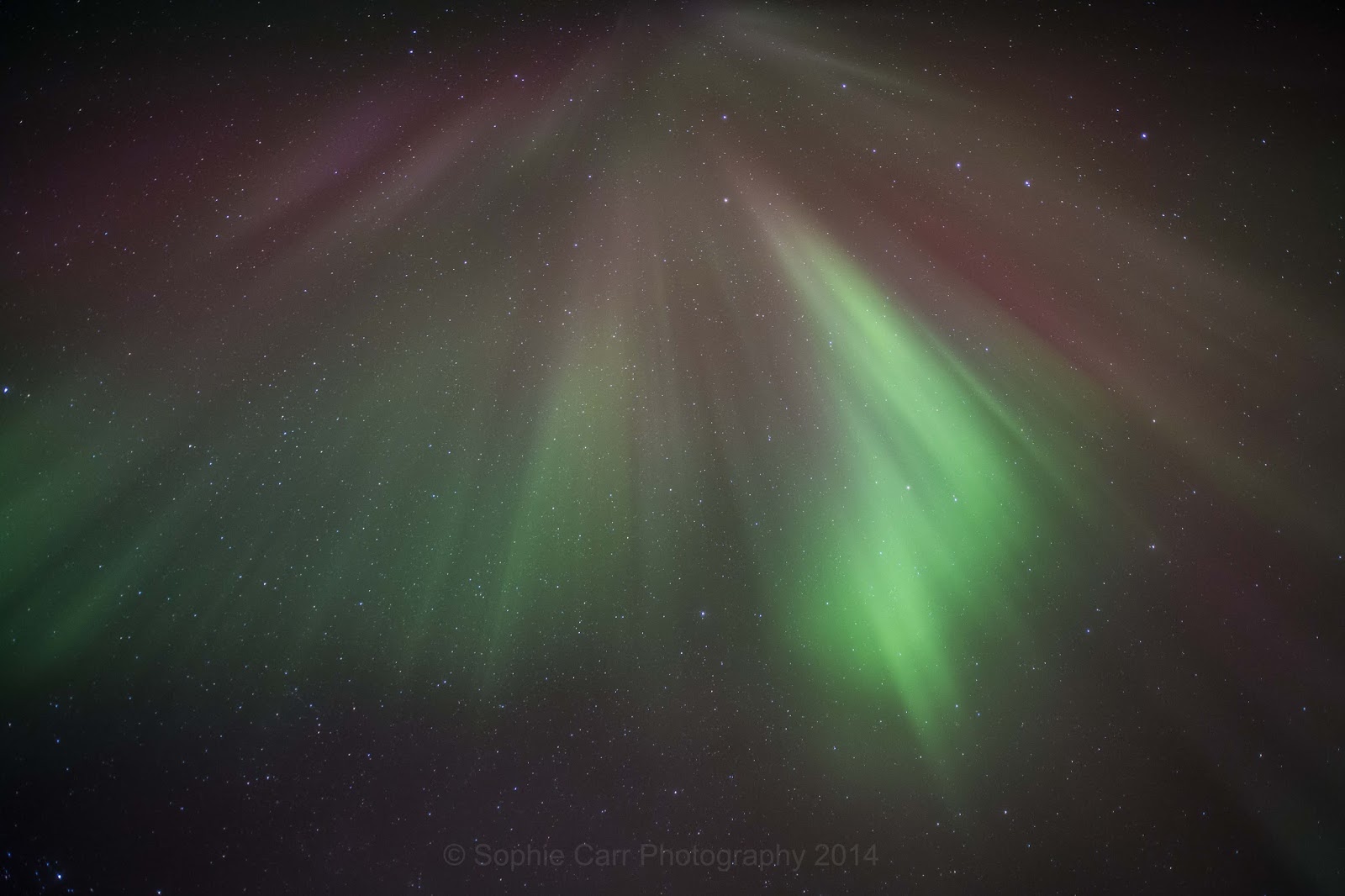 ISO 2500, f/2.8, 25 secs
ISO 2500, f/2.8, 25 secs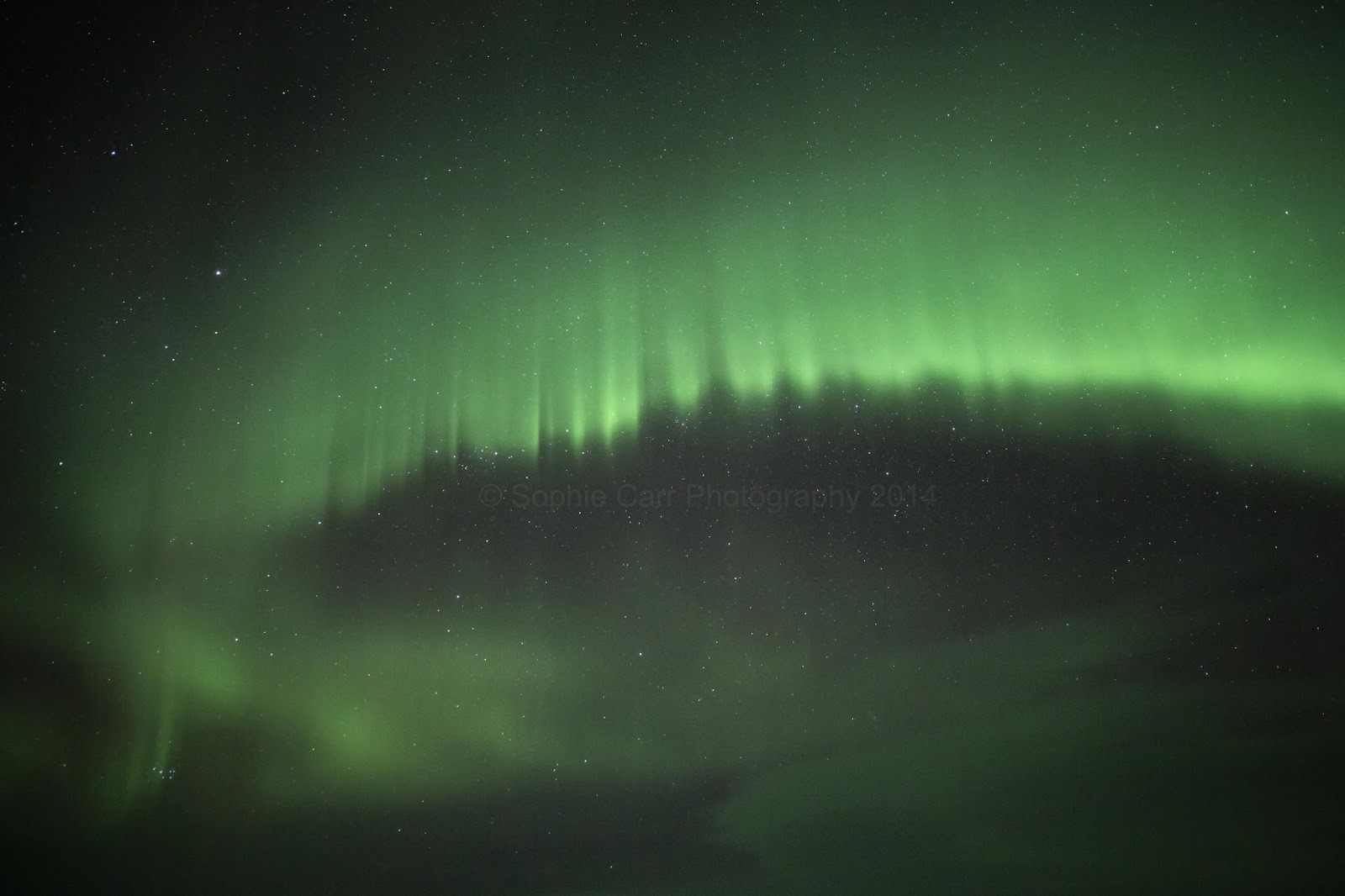 ISO 1600, f/2.8, 6 secs
ISO 1600, f/2.8, 6 secs
4) Do a trial shot with high ISO
I have a new little trick to help me with composition. Turn the ISO right up to 25,600 (or as high as yours will go), then compose the shot and review. Each shot at this high an ISO will only take a second or two, so much quicker than trying a longer shot only to find out that the composition is awful, or it's not in focus. Once you're happy, turn the ISO back to a less noisy one and take your long shots.
5) Try a few different locations
It is easy to get caught up in the moment, and just photograph the same view over and over again, worrying that if you move on the lights may stop. They may well do. Staying put might work well if the lights are interesting and moving around a lot, changing direction and colour, but sometimes they are fairly static and each shot will just end up looking the same. Tear yourself away, drive a couple of km, or even walk to a different spot - look for a different foreground. Look behind you! Bear in mind, however, that the lights are usually found to the north, and are mainly visible, then, from west to east across the horizon to the north, with little to see in the south. If you've found yourself a nice subject to the south it's less likely that the lights will be low enough in the sky to be included.
I have a new little trick to help me with composition. Turn the ISO right up to 25,600 (or as high as yours will go), then compose the shot and review. Each shot at this high an ISO will only take a second or two, so much quicker than trying a longer shot only to find out that the composition is awful, or it's not in focus. Once you're happy, turn the ISO back to a less noisy one and take your long shots.
5) Try a few different locations
It is easy to get caught up in the moment, and just photograph the same view over and over again, worrying that if you move on the lights may stop. They may well do. Staying put might work well if the lights are interesting and moving around a lot, changing direction and colour, but sometimes they are fairly static and each shot will just end up looking the same. Tear yourself away, drive a couple of km, or even walk to a different spot - look for a different foreground. Look behind you! Bear in mind, however, that the lights are usually found to the north, and are mainly visible, then, from west to east across the horizon to the north, with little to see in the south. If you've found yourself a nice subject to the south it's less likely that the lights will be low enough in the sky to be included.
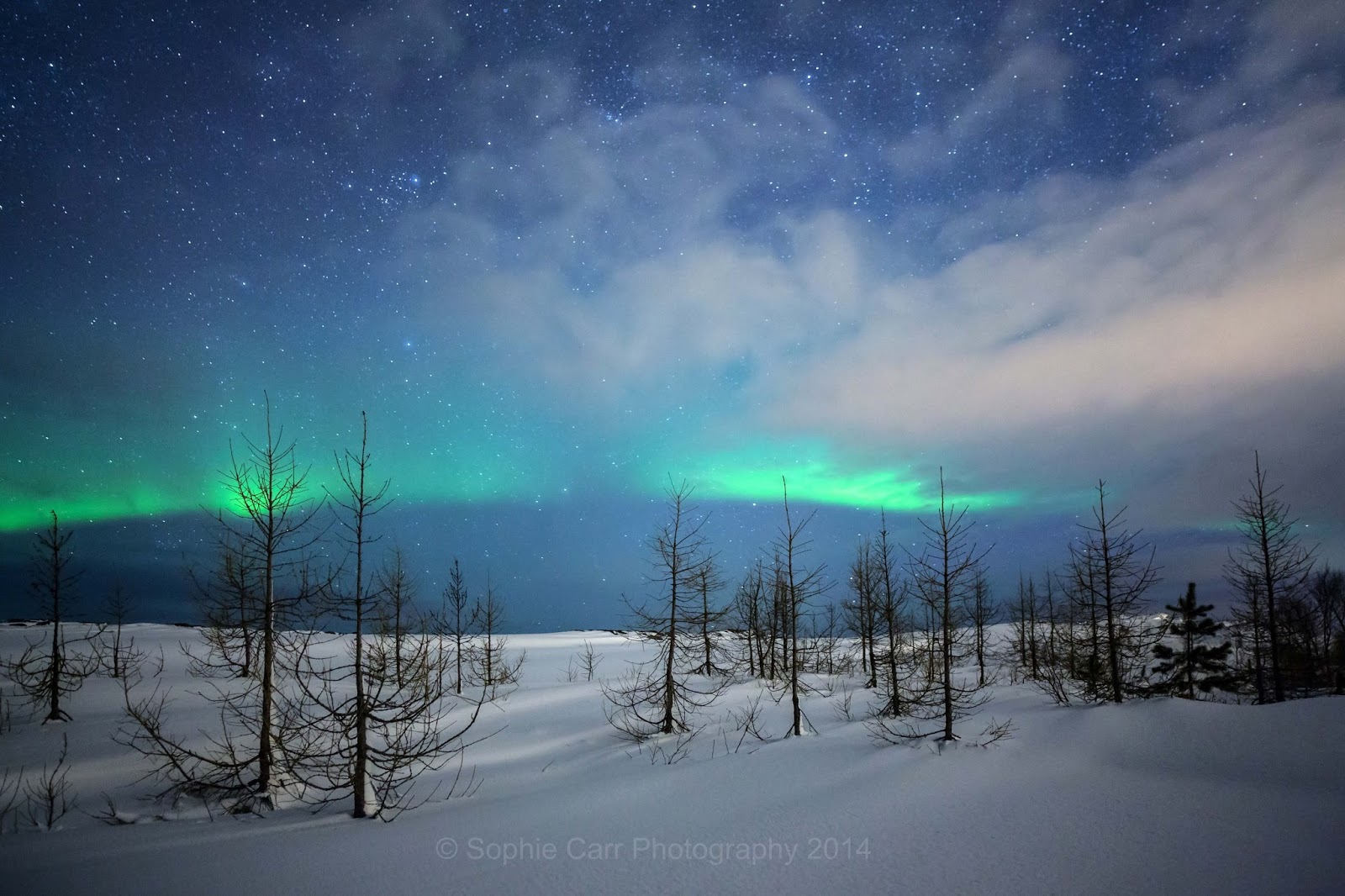 ISO 1600, f/2.8, 20 secs
ISO 1600, f/2.8, 20 secs
6) Shoot in RAW
Always shoot in RAW. Just do. Not just for northern lights; always! Makes post-processing so much easier. I once read that you should use daylight white balance for shooting northern lights, but I tried this and it gave a dreadful colour cast (which is obviously changeable if you shoot in RAW). I always used to use Auto White Balance, and then adjust in post-processing if need be, but now I customise it and use K=4200 or thereabouts, depending on the light and colours of the scene. Without RAW you're stuck with the white balance you've shot with and it's a lot harder to adjust.
Always shoot in RAW. Just do. Not just for northern lights; always! Makes post-processing so much easier. I once read that you should use daylight white balance for shooting northern lights, but I tried this and it gave a dreadful colour cast (which is obviously changeable if you shoot in RAW). I always used to use Auto White Balance, and then adjust in post-processing if need be, but now I customise it and use K=4200 or thereabouts, depending on the light and colours of the scene. Without RAW you're stuck with the white balance you've shot with and it's a lot harder to adjust.
 ISO 1600, f/2.8, 20 secs
ISO 1600, f/2.8, 20 secs
7) Always use a remote shutter-release or 2-second delay timer
Any movement from pressing the shutter will risk reducing the sharpness of the shot. If it's windy it might be an idea to check that the camera's strap isn't moving around causing slight vibrations to the body; same with the tripod - with some you can hang a bag beneath it to make it more sturdy. Some people recommend using the mirror lock-up, but I haven't found it makes any difference. If you don't have a remote release the 2-second delay timer works fine.
8) Post-processing
I do most of my processing in Photoshop Elements 12, which has Adobe Camera Raw (ACR) for converting the shots from RAW to jpegs, and then I use the Editor for a few more tweaks. In most packages you'll need to follow a few common steps: adjust white balance (to make the colours look "true" and realistic (and usually cooler if you're using AWB)), reduce noise (although not too much or you'll lose stars and detail), adjust the exposure, levels, clarity, contrast, adjusting shadows and highlights (especially if the lights are a bit blown out), etc. Shooting at f/2.8 and in the dark, at least you don't have to worry about dust spots. Not being able to see what you're shooting, though, will mean that you might still need to straighten out your horizon or crop bits and pieces here and there, even if you've done a test shot at high ISO.
Any movement from pressing the shutter will risk reducing the sharpness of the shot. If it's windy it might be an idea to check that the camera's strap isn't moving around causing slight vibrations to the body; same with the tripod - with some you can hang a bag beneath it to make it more sturdy. Some people recommend using the mirror lock-up, but I haven't found it makes any difference. If you don't have a remote release the 2-second delay timer works fine.
8) Post-processing
I do most of my processing in Photoshop Elements 12, which has Adobe Camera Raw (ACR) for converting the shots from RAW to jpegs, and then I use the Editor for a few more tweaks. In most packages you'll need to follow a few common steps: adjust white balance (to make the colours look "true" and realistic (and usually cooler if you're using AWB)), reduce noise (although not too much or you'll lose stars and detail), adjust the exposure, levels, clarity, contrast, adjusting shadows and highlights (especially if the lights are a bit blown out), etc. Shooting at f/2.8 and in the dark, at least you don't have to worry about dust spots. Not being able to see what you're shooting, though, will mean that you might still need to straighten out your horizon or crop bits and pieces here and there, even if you've done a test shot at high ISO.
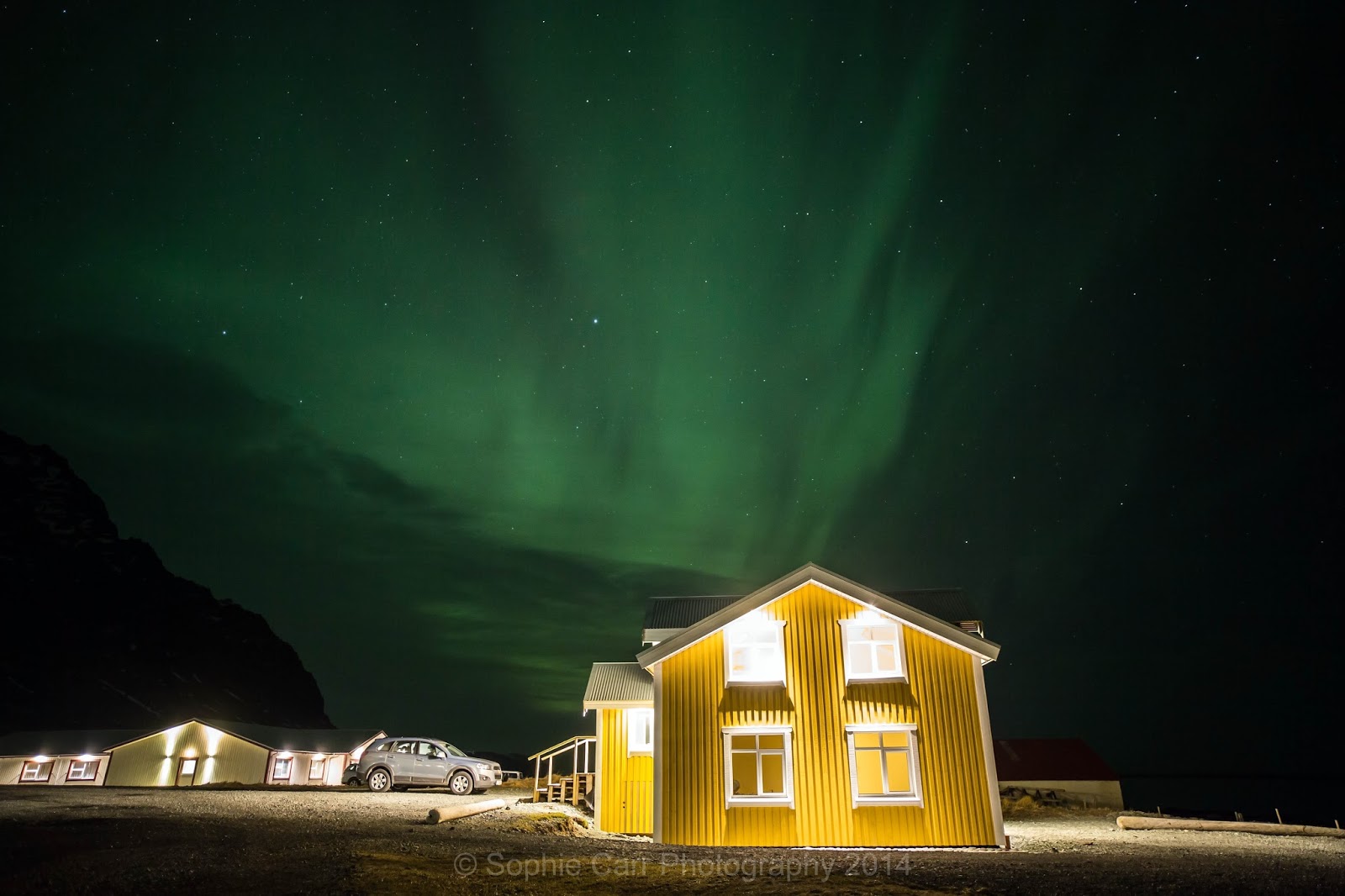 ISO 640, f/2.8, 5 secs
ISO 640, f/2.8, 5 secs
OTHER PREPARATION
There are loads of websites that give aurora forecasts, but bear in mind that even if good light activity is forecast, you may still not see it. Ditto with weather forecasts - remember that they're just forecasts, and may be wildly wrong (especially in somewhere like Iceland!). And sometimes the forecast is for no lights and then you hear reports from others that they miraculously appeared. Grrrrr! Even if the forecast is for low levels (under Kp=2.67) you might still get a good show in the distance. There are countless aurora alert twitterers, so have a search and follow some for up-to-date tweets!
Here's a couple of sites I've used:
http://www.spaceweatherlive.com/ (up-to-date aurora activity)
http://www.gi.alaska.edu/AuroraForecast/Europe (the long term one isn't very accurate)
http://en.vedur.is/weather/forecasts/aurora/ (for Iceland)
http://www.swpc.noaa.gov/communities/space-weather-enthusiasts (where most of the info used on other sites comes from - lots of detail I don't understand!) - this has a 27-day forecast which isn't always terribly accurate, but may include recurrence of coronal holes.
The My Aurora Forecast & Alerts app is good to have on your phone.
For weather forecasts in Iceland, I use these (not always accurate!):
http://en.vedur.is/weather/forecasts/areas/
http://www.yr.no/place/Iceland/Capital_Region/Reykjavik/
Sometimes you can still get a good view even if there is some cloud, so don't let that put you off altogether. The yr.no site seems to be pretty good all round, although never trust a forecast more than a couple of days away as it always changes in the meantime.
Also useful for Iceland, is to check the road conditions, especially if there's been any snow:
http://www.vegagerdin.is/english/road-conditions-and-weather/the-entire-country/island1e.html
OTHER ADVICE
1) The lights aren't that green in the flesh!
One thing that I have learned is that the lights are not as bright to the naked eye as what you see in photographs. Although I saw a great spectacle this time around, the colours were still muted. There was a tinge of green and pink, but really the lights do look a bit like streaks of cloud. If lights are forecast and the sky is clear, head out and do a few test shots. You may not see the lights, but the camera will find them with a long exposure! And then you never know, they might get brighter.
I think it is important to manage people's expectations, so I've processed an image to show what the lights look like to the naked eye:
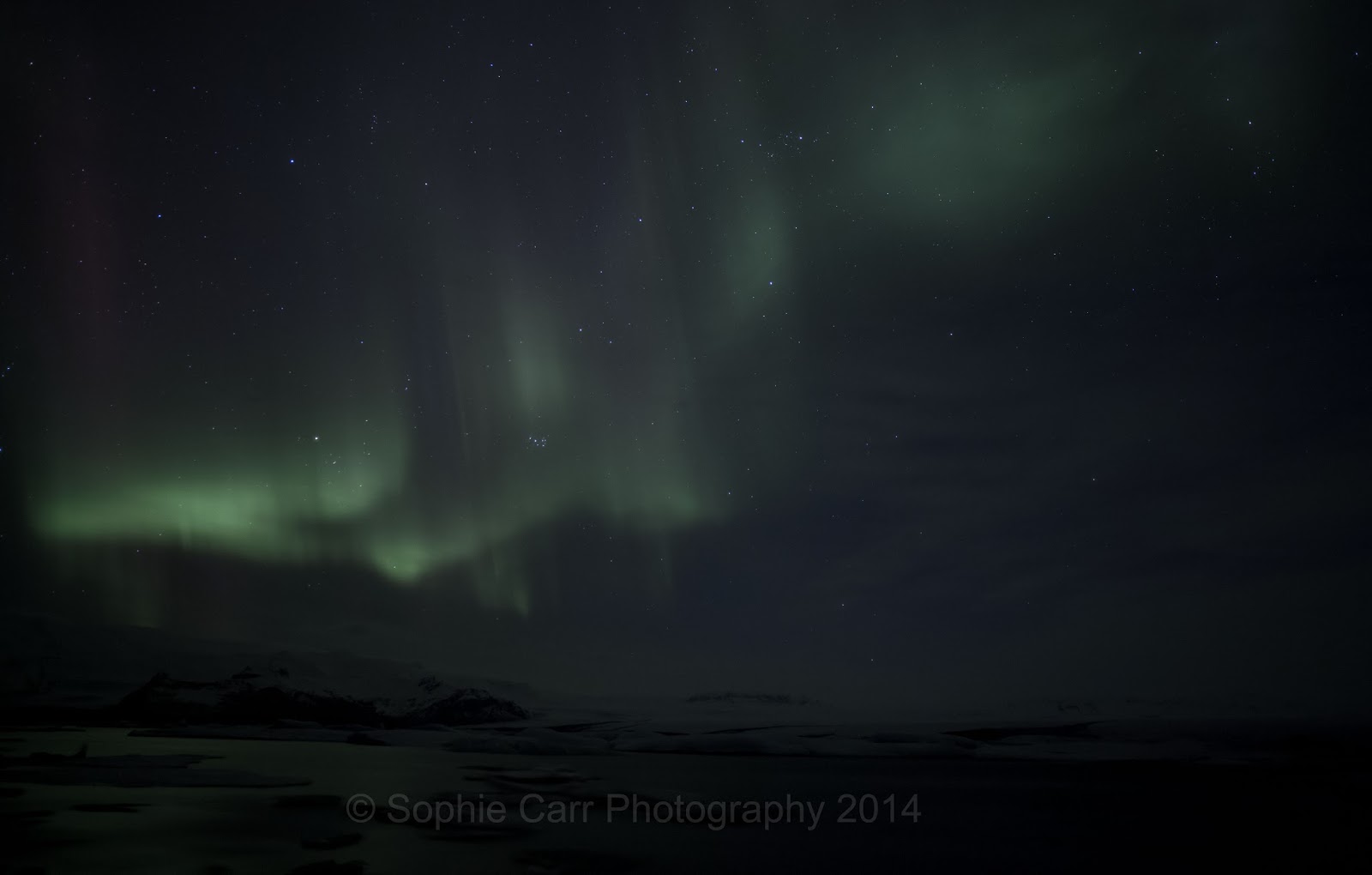 ISO 2500, f/2.8, 8 secs
ISO 2500, f/2.8, 8 secs
And what they look like to the camera (with a little bit of post-processing too):
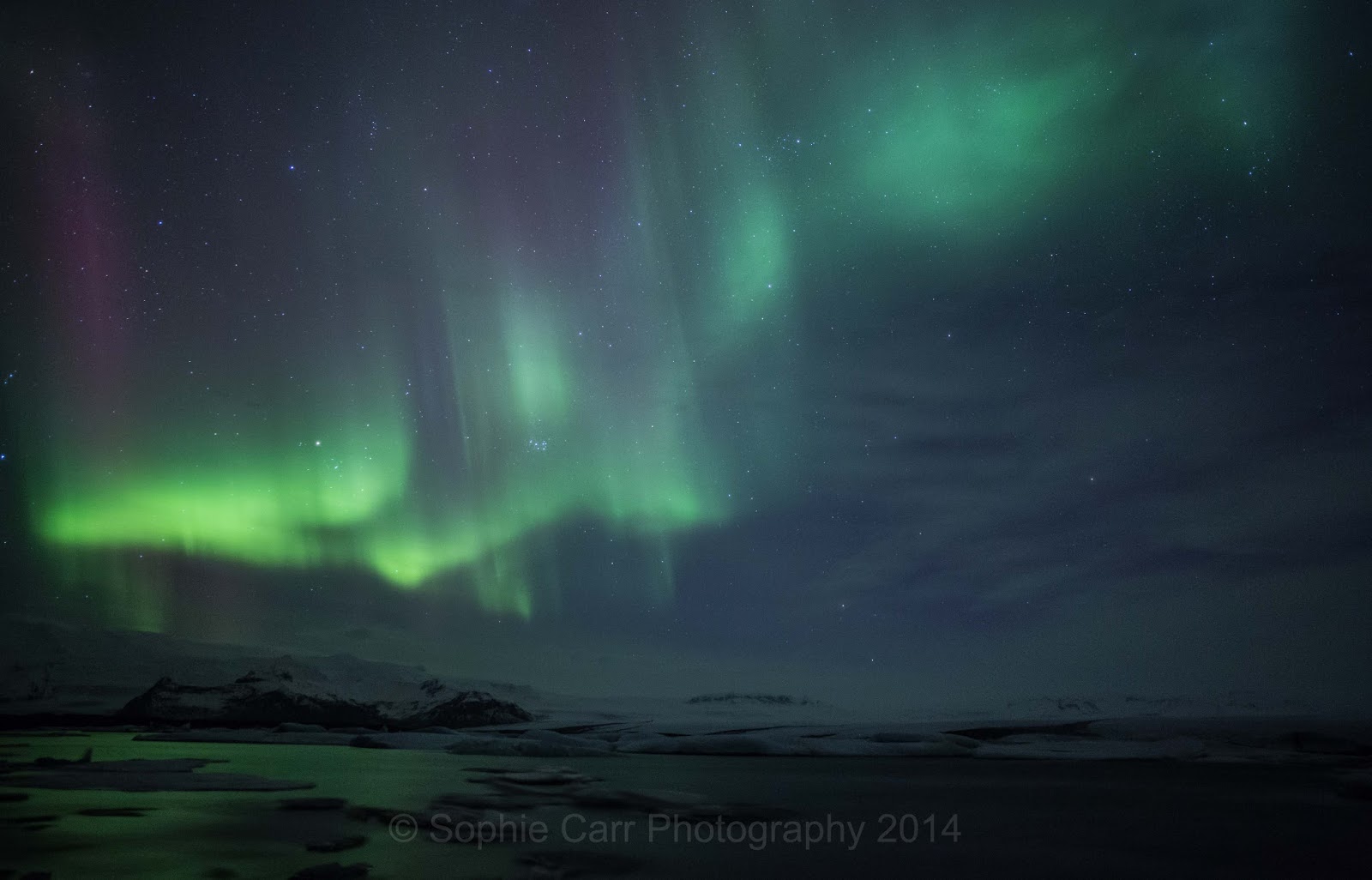 ISO 2500, f/2.8, 8 secs
ISO 2500, f/2.8, 8 secs
2) You may well not see them!
I've spent about 30 days in Iceland in late March, which is a good time of year for auroral activity. I have seen auroral activity during that time on about 4 occasions. The reason for this is 1) it is usually cloudy, and 2) there isn't auroral activity all the time, even if it is forecast. The further north you are, the better the chance, but also bear in mind that you may not see them. Try not to be disappointed and base your whole trip around trying to see them.
3) Try star shots instead.
If it's clear and there are no lights, try to take some star shots instead. You could try doing multiple (maybe 60) shots of 30 seconds each. If you want a circular effect find the north star as the stars revolve around that. Again, make sure there's something of interest in the foreground. An intervalometer is useful for star trail shots as you can programme it to take a certain amount of shots of the same length with a short interval in-between. You could also try to get a shot of the Milky Way.
4) Be aware of the moon
If there's a full moon there will be a lot of ambient light, which will make the lights more difficult to see and photograph (although shutter speeds can be reduced as there is ambient light). Some people suggest that if you're going to somewhere like Iceland in autumn then the moonlight will help to light up the foreground as there is less likely to be snow. If you go in the second half of winter there's more likely to be snow - if there's moonlight there may be far too much light reflected off it. Use a tool like The Photographer's Ephemeris to plan when the moon will be around - even if there is a full moon, look at the moonrise and moonset times, as the moon could well be below the horizon. This year I went just after the full moon, but checked that the moon was below the horizon during the evening and early hours.
5) Make your trip about something else
If you see the lights it will be an added bonus, but as mentioned above, try not to build a holiday or photography trip around it, as you might well be disappointed. Iceland tourism adverts play on everyone's desire to see the lights, but often fail to deliver - fortunately Iceland has enough to offer during the day so that you can't really be disappointed. Just set your expectations at a realistic level!
6) It can be really tiring!
If you're lucky enough to see the lights, or even just out trying, the chances are it's going to be in the very late evening or early hours, or even just before dawn. If you're up for sunrise too this all gets very tiring, so just try to give yourself some time to recover from time to time. On my last trip I was extremely grateful for two separate days of rain so that I could catch up on sleep!
7) You may not be alone...
If you're in a popular destination, the chances are that you won't be alone viewing the northern lights. I was alone on my first night in Egilsstadir, but a couple of nights later in Jokulsarlon I headed down to the lagoon where I expected to see a few other photographers, but in fact found myself surrounded by a coach-load of cackling Japanese tourists. It didn't make for a very ethereal experience... (which it might have been without their chorus). I met someone on the plane home who'd been on a tour from Reykjavik and they specifically asked (and paid more) for a small group trip, as they didn't want to be with a coach-load. It turns out that the small group was one of about 5 or 6 small groups who all turned up at the same place, so not what she had expected either!
Hopefully this has been a bit helpful for you! Please share if it has!
I've spent about 30 days in Iceland in late March, which is a good time of year for auroral activity. I have seen auroral activity during that time on about 4 occasions. The reason for this is 1) it is usually cloudy, and 2) there isn't auroral activity all the time, even if it is forecast. The further north you are, the better the chance, but also bear in mind that you may not see them. Try not to be disappointed and base your whole trip around trying to see them.
3) Try star shots instead.
If it's clear and there are no lights, try to take some star shots instead. You could try doing multiple (maybe 60) shots of 30 seconds each. If you want a circular effect find the north star as the stars revolve around that. Again, make sure there's something of interest in the foreground. An intervalometer is useful for star trail shots as you can programme it to take a certain amount of shots of the same length with a short interval in-between. You could also try to get a shot of the Milky Way.
4) Be aware of the moon
If there's a full moon there will be a lot of ambient light, which will make the lights more difficult to see and photograph (although shutter speeds can be reduced as there is ambient light). Some people suggest that if you're going to somewhere like Iceland in autumn then the moonlight will help to light up the foreground as there is less likely to be snow. If you go in the second half of winter there's more likely to be snow - if there's moonlight there may be far too much light reflected off it. Use a tool like The Photographer's Ephemeris to plan when the moon will be around - even if there is a full moon, look at the moonrise and moonset times, as the moon could well be below the horizon. This year I went just after the full moon, but checked that the moon was below the horizon during the evening and early hours.
5) Make your trip about something else
If you see the lights it will be an added bonus, but as mentioned above, try not to build a holiday or photography trip around it, as you might well be disappointed. Iceland tourism adverts play on everyone's desire to see the lights, but often fail to deliver - fortunately Iceland has enough to offer during the day so that you can't really be disappointed. Just set your expectations at a realistic level!
6) It can be really tiring!
If you're lucky enough to see the lights, or even just out trying, the chances are it's going to be in the very late evening or early hours, or even just before dawn. If you're up for sunrise too this all gets very tiring, so just try to give yourself some time to recover from time to time. On my last trip I was extremely grateful for two separate days of rain so that I could catch up on sleep!
7) You may not be alone...
If you're in a popular destination, the chances are that you won't be alone viewing the northern lights. I was alone on my first night in Egilsstadir, but a couple of nights later in Jokulsarlon I headed down to the lagoon where I expected to see a few other photographers, but in fact found myself surrounded by a coach-load of cackling Japanese tourists. It didn't make for a very ethereal experience... (which it might have been without their chorus). I met someone on the plane home who'd been on a tour from Reykjavik and they specifically asked (and paid more) for a small group trip, as they didn't want to be with a coach-load. It turns out that the small group was one of about 5 or 6 small groups who all turned up at the same place, so not what she had expected either!
Hopefully this has been a bit helpful for you! Please share if it has!





















